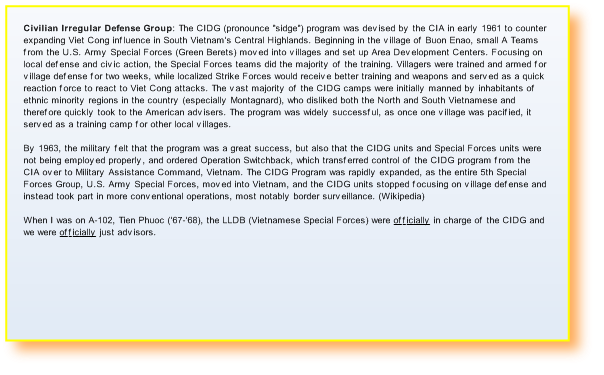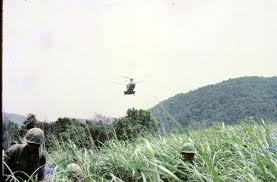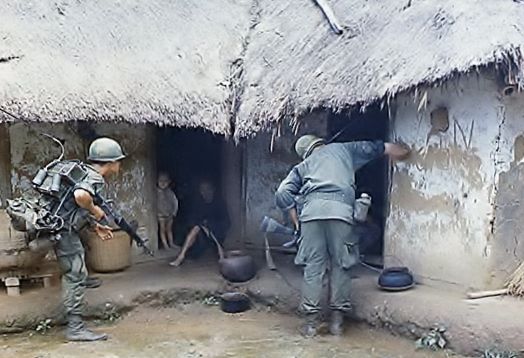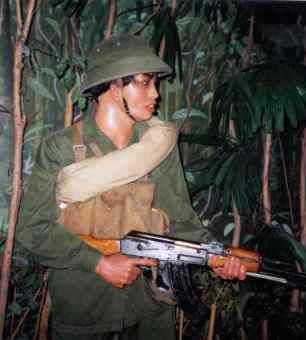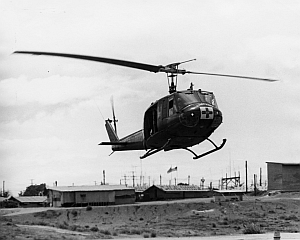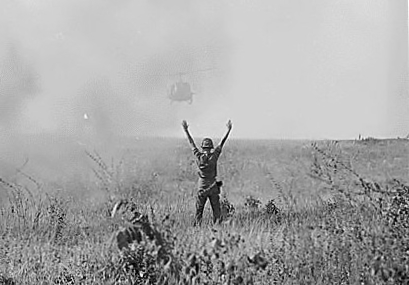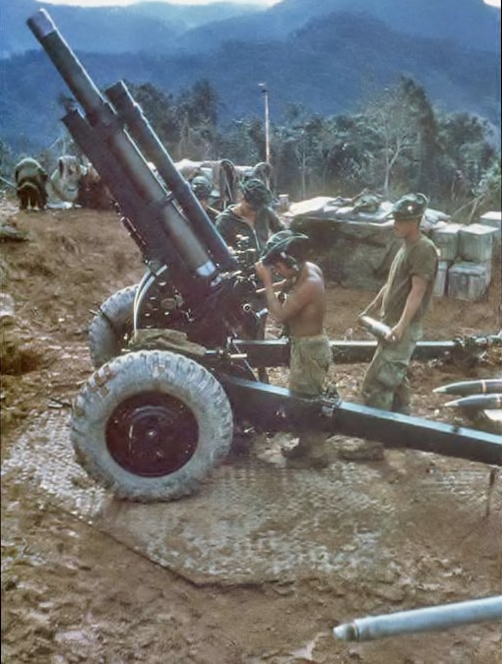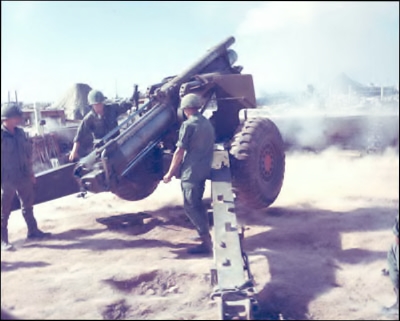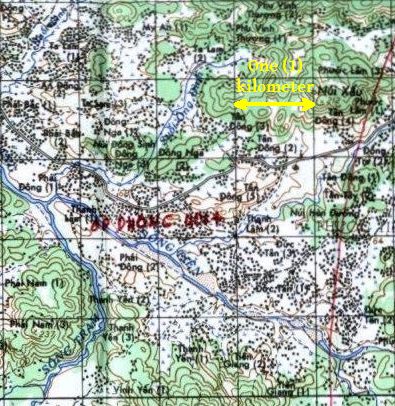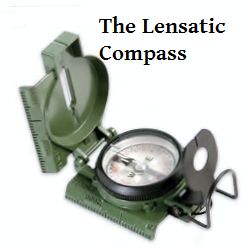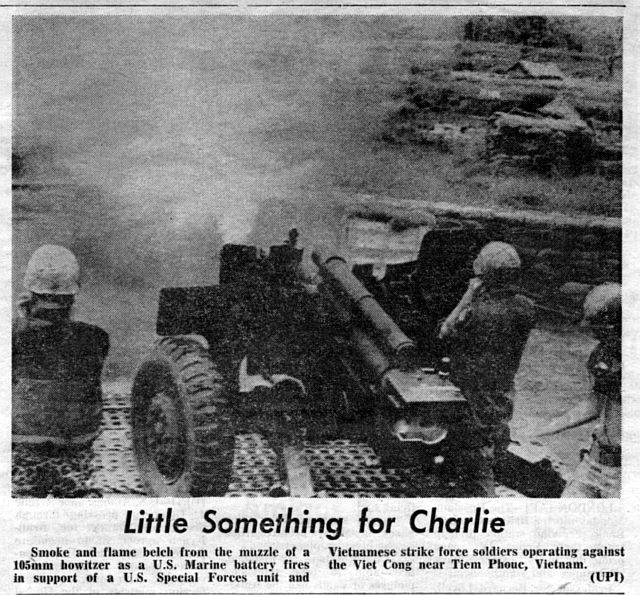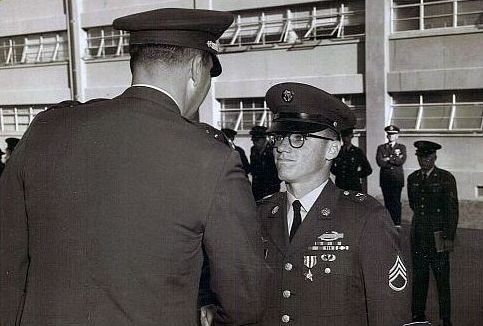DATE: 23 december 1967
Out of Special Forces A-Camp, Tien Phouc
Mission: Harrassment and interdiction
Force: Two USASF: SFC Lawrence Beals and myself, SSG Mike Stahl; Two LLDB (Luc Long Duc Biet
[Vietnamese Special Forces]) and one company (approximately 100 men) of CIDG (Civilian Irregular
Back Story: I had been running mission like this since my arrival at Tien Phouc in August. For this entire
time, intelligence indicated there were very few VC (Viet Cong = VC = Victor Charlie, i.e. Charlies) in our
AO (Area of Operation). When I first arrived, my counterpart, the LLDB Intelligence Sargeant told me
that there were three know VC, all women, in the vill (village) and they shared one old French Garand rifle
for which they had no ammunition. They acquired some American .30 caliber ammo for the M-1 Garand
which they beat with a rock to get it to chamber. At least, that is what I was told. There were also three
know VC in our CIDG force.
I don’t remember how many patrols I had been on prior to this one, but I had been out regularly, being the
most "combat expendable" man on the team and I preferred it in the boonies. Consequently, I was the more
experience round eye (how we referred to ourselves to differentiate us from the Vietnamese who had the
oriental ‘almond’ shaped eyes). I had never been in contact before because of the ‘understanding’ between
our indigenous troops and the local VC.
The Incident: We had been out for several days and were on our way back to the A-Camp with one more
night in the field planned. We took a break in an east-west valley and Sgt. Beals moved forward to discuss
plans with me. I always preferred to position myself just behind the point squad. The point squad was
ostensively the more experienced and reliable indig who acted as the immediate reaction force should the
point man make contact (which had never happened).
Although we Americans were officially just advisors to our LLDB counterparts, they were seldom seen on
these operations and pretty much just deferred to us. Where Sgt. Beals and I were taking our break there
was a sloping gully cutting into the mountain to our south. I noted to Beals that in the time I had been there,
we had never run a patrol into that next valley to our south, which was on the very edge of our AO. I
suggested that we follow the gully up onto the mountain. Select a night defensive position and then descend
into the southern valley at first light.
I made a comm check with the A-Team and let them know what we wanted to do and MSG Harris, out
team Sargent, approved the change. After the break, I re-directed the point man who looked none to happy
at the change. It was a pretty steep climb with lots of vegetation and it began to rain.
Just before last light, we found a suitable location and I saw that our troops were deployed into a defensive
perimeter. I strung my hammock between two trees and rigged my poncho over it as best I could to keep
the rain off me. Sleeping on the ground could be safer - the VC were known to recon by fire at about
waste height - but the ground was usually crawling with leeches which were a bigger threat. I crawled into
my hammock, wrapped in my poncho liner (a real luxury as even when wet, it held in body heat) and went
to sleep. A soldier does not sleep soundly at night in the jungle. I awoke once to find the rain had become
quite heavy and was running down the ropes of my hammock, keeping me soaking wet, in spite of my
‘tent.’ And my right cheek was itching like crazy. A reach to scratch found a grape sized slimy blob
hanging there. F*ing leech filled with my blood. Leeches cannot just be pulled off due to the nature of their
mouth hooks. We were issued small bottles of insect repellent which we did not use regularly because the
scent could be detected by the bad guys. But it was the perfect remedy for leeches. A small squirt and they
would shrivel up, die and fall off. Of course, because of the anticoagulant they injected, the wound would
continue to bleed for hours.
It was pitch dark when we prepared to move out. In double and triple canopy rain forest, little light reaches
the ground, even during a full moon. That morning, there was no moon. A good soldier learns to be able to
unpack and pack in total darkness. The next problem is keeping the men in the column from getting lost.
One does not want to be too close to the man in front in case he steps on a mine or booby trap. The juggled
provided a unique solution. The rotting leaves scattering the ground had a unique fungus growing on them.
The fungus was phosphorescent - glowed softly in the dark.
As we formed up to move out, each man would take a damp leaf and stick it to the back of the pack on the
man in front of him. As we ascended the slope, the going got rougher. Not only did the terrain get steeper,
the trees got closer together and the ‘wait-a-minute’ vines grew denser. It was critical to stay close enough
to the man in front to keep an eye on the bobbing splotch of phosphorescent light - without getting to close.
A slip on the wet, slimy leaves by one man could separate the force in two.
Finally, light started creeping through the canopy and I could see the last man of the point squad. Then
disaster. The trees closed in on and we were traversing a steep slope. We could not move up and down
slope was a sharp drop-off. The point squad squeezed through a narrow gap in the trees and there was a
dense group of those damned ‘wait-a-minute’ vines.
When I got to the gap, it was just a skosh too narrow for this American. I had to squeeze through as best I
could. And then vines entangled my pack and web gear. The point squad kept moving. The Vietnamese did
their best to clear the vines and push me through the narrow opening. A light coat of vegetable oil would
have been nice. Finally I broke through. But there was no sight of the point squad.
There was a 'sign' of their track, however, and I rushed to catch up. After what seemed like an eternity, I
broke out of the jungle into a large patch of tall elephant grass and was elated to see the clear tail of my
men through the grass. I was, indeed, behind the point squad. I followed their trail into the tall grass and
then . . .
F*ck!!!! The trail split!! (A path into the woods). One path went straight and a second veered off heading
down hill. It didn't take a super computer to analyze this situation. My point squad would not have gone in
two different directions. Both trails were fresh and were made by several men. I quickly decided that my
point guys realizing they were following someone else, probably not friendlies, would divert to avoid contact
(which was their wont.) Using the age old WAG system, I headed down slope.
The trail lead into a thinning jungle which I broke out of almost immediately at the edge of an not that old
bomb crater. There was a very large hole with all the trees laying out in a radius. Large bombs falling in a
dense jungle have a very limited effect as the jungle absorbs the blast. I circled the crater and was
approaching a fallen tree on the far side when the Fourth of July started to be celebrated to my front. It
was surreal. After three months of strolls in the woods, an honest to gosh fire fight.
The excellent training I had received at Smoke Bomb Hill kicked in and I rushed forward. Just as I leap
over a tree, I saw my point squad in hasty retreat. I was experiencing the biggest adrenalin rush of my life.
I had no choice but assault. It was text book. When the little people (another term for the indig) saw me
‘charge’ they turned to follow and the rest of the company had to choice but to join the assault. To turn and
run (retreat) would have meant almost certain death. And I had the only radio with me and it took an
American on that radio to get artillery or air support and to call in a medevac.
There was only a thin strip of trees between the bomb carter and a thatched hooch. I had become the
defacto point man. At the corner of the hooch, I saw my first enemy soldier. And he was no VC. Tan
uniform, pith helmet, AK-47 and NVA web gear. He had been turning back to the left when he saw me.
He swung quickly back to the right, his AK spitting fire. I was caught in a slow motion nightmare, about to
be cut down in my prime. It seemed like it took hours. Before he completed his arc back to me, he ran out
of ammo and my M-16, without any assistance from me, spit three rounds into his chest. Apparently, he had
not been trained to point and shoot. And the rapid rate of fire of the AK (and the probability that he did not
have a full magazine) caused him to expend his ammunition before his weapon was pointed at me.
By then, my men were charging past me and I joined them at the front of the hooch. (We had approached
from the back side.) The hooch had a field table in the center and a tunnel entrance in the left-rear corner.
There were 3 NVA packs on the table and there were 2 dead NVA officer on the floor. There was a
Vietnamese woman, dead (which made her a VC) laying half in the vertical tunnel. It looked like she died
trying to lower herself. There was blood and blood trails everywhere.
I quick inspection of the packs showed me we were in way over our heads. Nothing but maps and
documents. No supplies. This was a headquarters unit of a large force. As the ringing in my ears subsided,
I realized I was listening to a small child crying. The sound was emanating from the tunnel entrance.
Several CIDG were around the hole in the floor ordering anyone in there to come out. I joined them and
through my interpreter, told them to surrender. No response except for the crying child - maybe two or
three, I guessed. The child could be alone. Vietnamese civilians could be down there. NVA soldiers could
also have made it into the safety of the tunnel. My troops were getting very nervous, and rightfully so. A
superior force was probably massing for an attack.
I worried about the child. One of my guys, unbeknownst to me, pulled the pin on an old WWII/Korean War
grenade and dropped it into the hole. I was shocked. The child! One-thousand, two-thousand, three-
thousand, four-thousand, five-thousand, six-thousand . . . no explosion. A dud? A slow cooker? I dropped
my pack and pulled my Colt .45 and was about to lower myself into the tunnel entrance (much to the
distress of the Vietnamese around me) when I smelled smoke. Someone had set the hooch on fire. Some of
my men grabbed me and my gear and dragged me outside as the hooch was engulfed in flame. I still
wonder if that tunnel had the usual second exit or if it was dug just as a bomb shelter. I prefer to think that
the kid survived.
Outside the hooch, my men were in complete disarray. Things like this were not supposed to happen. They
were not supposed to make contact. There were rules, after all. And we all knew that whatever force was
there, they were well trained NVA, not some local VC force. One of my guys was being assisted by two
friends as he tried to one legged hop down a trail away from the hooch. I organized my guys as best I could
into a defensive perimeter and called for a medevac. There was a knoll a short distance to our north-east
with a small clearing on the top. I carried the wounded man to its top and arrived got there just as the Dust
Off arrived. I threw a yellow smoke and when the pilot identified the yellow smoke, I threw a red. This
technique was needed to ensure the bad guys did not trick a chopper pilot into landing on the wrong LZ
(landing zone) and being ambushed.
There is a procedure for bringing in a Huey into a small LZ. The ground man stands with his back to the
he is over the clearing the arms are lowered and the hands are used to signal him to descend. I had never
done this before but knew the proper procedure. I did almost everything right except I was facing into the
light breeze. (All aircraft land into the wind.) Luckily the pilot was sharp enough to believe the blowing
smoke and disregard me and swung around 180 degrees to come into the wind. And I was smart enough to
run around to the other edge of the LZ and land him properly. After loading our wounded (We had no
friendly KIA’s in spite of what you might have read elsewhere.), I headed back down to the trail that lead
north from the hooch. The company was moving rapidly, but orderly, up the trail. I joined them and with
long strides, moved to the head of the column.
We passed to the east of a large rice paddy and the trail ascended a hill and tuned east where we had a
dominant view of our back trail and the paddy. The bad guys were in pursuit.
We were having join operations with the 101st Airborne Division at the time and they had a battery of
155mm howitzers at the A-Camp. I had FOed (A Forward Observer, usually a man attached from the
artillery unit, is a guy trained to call in and direct artillery support.) for the Marine 105's before but this was
the first time I had used the 155's.
I called in a fire mission on the troops that were crossing the rice paddy coming right at us. My position was
directly on the line of fire between the tubes (artillery pieces) and the bad guys. And we were near the top
of the hill.
A little about Artty in Nam: calling in artillery fire is a very precise operation. Almost everyone has seen the
war movie where some poor slob calls in artillery on his own position, sometimes euphemistically known as
"friendly fire." That's why it was normal to have an FO (Forward Observer) from the supporting unit with
the infantry unit to do the job. Sfers did the job ourselves.
First, the FO's position must be determined using the topographic map. That position is given to the FDC
(Fire Direction Control) along with the azimuth (compass direction in degrees) and distance (in meters) to
the target. This distance was usually underestimated. One round is fired. Hopefully, it lands past the good
guys and just short of the bad guys. A correction is given to FDC - say "add five-zero meters; right three-
zero meters" and a second round is fired. The rounds are thereby 'walked' to the target. This works fine in
practice and with a stationary target like a 'front line' or 'bunker.' It becomes a bit more difficult with a
rapidly advancing force.
The USMC artillery we had at Tien Phouc were the best. Those guys could put a round in your back
pocket if you could tell them were it was. But their equipment was old - very old, and, therefore, imprecise.
After the 'spotter' round was directed close to the target, the real fire mission would begin with a command
something like, " Six rounds, HE (high explosive), fire for effect." Which basically meant, "We've got them
nailed. Blow the crap out of them!" Because of the age of the Marine's tubes, there was a natural deviation
in where each round fired went. Not so with the 101st's 155's.
Back to the story:
The first surprise was hearing the round pass overhead. One soon learned in Nam that if you heard a
mortar round coming in, you were dead meat. Mortars have a very high trajectory. Almost straight up and
then almost straight down. It was more than bad luck to hear it screaming through the air. The only time
one heard artillery rounds was when they were passing almost directly overhead and that meant you were
okay.
So, right after hearing this 155 round pass directly over my head, there was this horrendous explosion in the
rice paddy, right where I needed it. In excitement (I might live out the rest of the day, after-all.), I gave the
command to fire for effect. As I remember it there were six tubes in the battery. In any event, all but one
of the rounds exploded almost simultaneously in almost the same place. And one round was about 10
meters to the right and 10 meters long. Sent the Charlies running for their lives and broke their counter-
attack.
While I was watching the show down in the rice paddy below us, I failed to notice the rapid movement of
men past me on the trail. Our CIDG were not particularly brave fighters and we were obviously
outnumbered. The trail we were on headed back to the hamlets south of the village of Tien Phouc and my
guys wanted back to camp - now. They started at the double and then broke into a dead run as panic
overtook them.
I don't actually remember much of the return except for being grateful for all that running we had to do in
jump school and all the emphasis on PT in airborne and special forces. I mostly remember running on a trail
between rice paddies and banana trees. The leaves of the banana trees were heavy with the monsoon rains
and kept slapping me across the face as I ran. Wearing glasses was a mixed blessing. The glasses
protected my eyes from debris and damage but it was like driving in a heavy downpour with a broken
windshield wiper. I just kept hoping the blur in front of me was one of my guys and he was going the right
way. With these guys it was keep up or be left behind.
I managed to keep up and we all got back safe. I did not earn any accolades for this action, but I was
Inspection of the documents we had recovered showed we were indeed up against a far superior force.
We had walked into an NVA battalion headquarters and maps showed a planned offensive on the coastal
city of Tam Key. That's probably why the decoration was awarded.
|



SFC Michael G. Stahl, USASF (Ret.)

The Life and Times of
First Contact

